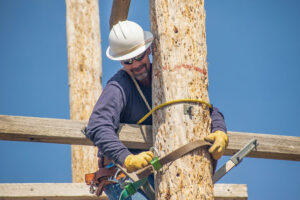Would you know what to do if you encountered an electric shock accident? Knowing critical information ahead of time will help protect you and could save someone’s life. The Safe Electricity program encourages you to be prepared by learning the symptoms of electric shock and knowing how to help someone who gets shocked by electricity.
“Human beings are good conductors of electricity. That means that electricity can easily pass through our bodies,” explains Jim Miles, Association of Illinois Electric Cooperatives vice president of training, safety and loss control. “In the right conditions, electrical contact can cause serious injury or death.”
In most situations, there are safeguards to keep us isolated from the dangers of electricity, like high-voltage power lines high on poles or buried underground, insulated wires on tools and appliances, and ground fault circuit interrupters (GFCIs) on outlets in locations where water and electricity might come together. However, sometimes through accidents, equipment failure, or poor decision making, our bodies come into contact with electricity with tragic results.
According to the National Institutes of Health and the U.S. National Library of Medicine, electric current can cause injury to our bodies in three ways: cardiac arrest from the electrical effect on the heart; muscle, nerve and tissue destruction from the current passing through the body; and thermal burns from contact with the electrical source. In many cases, injury is obvious with the electricity causing heart stoppage, burns, broken bones and seizures. In other cases, the injury might not be as evident, because electrical contact affects the body from the inside out.
If you or a loved one is involved in contact with electricity and there are no obvious injuries, watch for these symptoms that something is wrong:
- Changes in alertness
- Headache
- Problems with vision, swallowing, or hearing
- Irregular heartbeat
- Muscle spasm and pain
- Numbness or tingling
- Breathing problems
If you come upon someone who you believe is in contact or has just suffered an electrical shock:
- Look first. Do NOT touch. The person may still be in contact with the electrical source and be energized. Touching the person could pass the current through you. If there are others nearby, make sure they do not touch the person either.
- Call 911 and the electric cooperative, or have someone nearby call.
- Turn off the source of electricity, if known and if safely possible (i.e., circuit breaker or box). If you are not sure, wait for help from emergency responders.
- Only once the source of electricity is OFF, check for signs of circulation (breathing, coughing, or movement). Provide any necessary first aid.
- Prevent shock. Lay the person down and, if possible, position the head slightly lower than the trunk with the legs elevated.
- Do not move a person with an electrical injury unless the person is in immediate danger.
Remember—DO NOT touch the person if he or she is still in contact with the electrical current. Do not get near high-voltage wires until the power is turned off. Call 911 and the utility to have them come and de-energize the lines.
Anyone who has come into contact with electricity should see a doctor to check for internal injuries, even if he or she has no obvious signs or symptoms.
For more information on staying safe around electricity, go to SafeElectricity.org.








